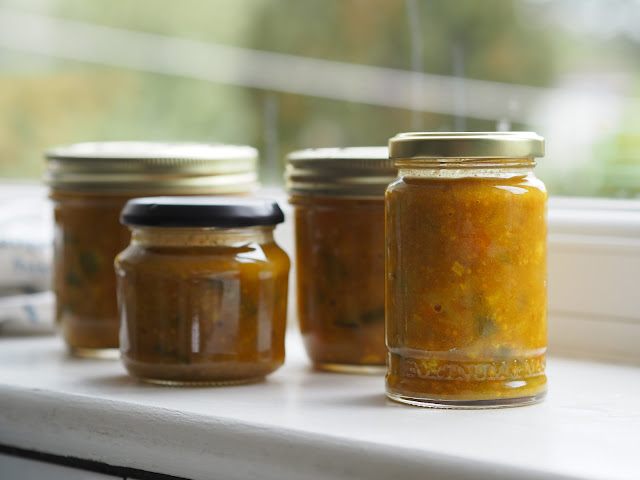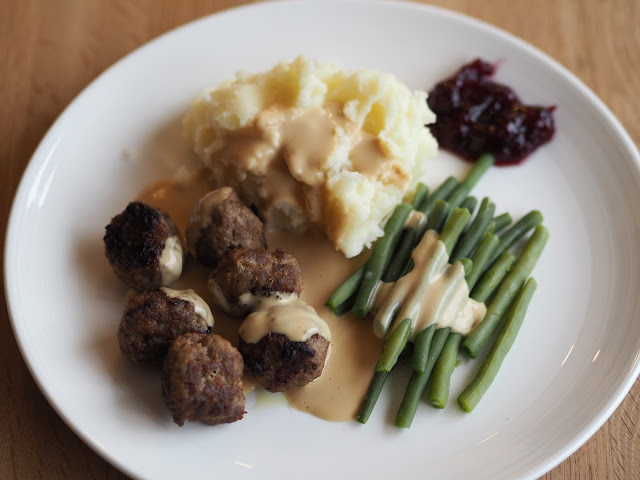Cooking my way through my recipe books began as a monthly challenge, a way to find some different family meals and to make sure I really got the most out of my large and constantly (happily, determinedly) growing collection of cookery books. If you click on the "Cookery Calendar Challenge" label to the right you can see all the posts over the years. Now the thought of having time to do this kind of cooking and blog post monthly is laughable, but it has instead become a school holiday indulgence, a relaxed pleasure to enjoy when I have one or two weeks off work and some free time at home to potter away in the kitchen.
This post's book was utterly perfect for that: The Little Library Year by Kate Young. Last August I blogged about cooking from her first book, called the Little Library Cookbook, and her second book has the same literary inspiration but is instead organised seasonally. As well as recipes inspired by meals in books, she offers up wonderful lists of suggested titles and authors for different points in the year, or different moods, at the start of each section. The author's passion for reading is evident in every page - even the endpapers contain photographs of her bookshelves.
Let's work through the recipes seasonally. From the "Winter Pickles section of the chapter entitled The Long Winter Nights I made piccalilli, a mustard-based chutney. Preserving is not something I would usually do in the spring but John's birthday is coming up and he loves piccalilli, it is something we always keep in the fridge, and so I thought I would make him some.
After a thorough rinse, you mix together vinegar and spices (including the mustard powder and turmeric that gives piccalilli its characteristically yellow glow) then simmer the vegetables in the vinegar for ten minutes.
Then you remove the vegetables, add sugar and cornflour to the vinegar and simmer until it is thick, before putting the vegetables back in and spooning into jars.
I have never made a pickle like this. I usually make chutney, where everything is simmered together until it is quite soft, so I'm keen to see what this is like. It is currently hidden away in a dark place until John's birthday in June when we can try it.
From the same chapter, I baked peanut butter, honey and banana loaf. This was definitely at the banana bread end of the spectrum of banana based baking, dense and heavy with fruit, whereas the banana chocolate loaf cake I often make feels lighter, more cake-y.
Moving into the chapter entitled Spring in abundance, I baked "omelette aux fines herbs" or omelette with chopped fresh herbs. I had just been to the garden centre and stocked up my collection of fresh herbs for the garden, so used a mixture of chives, parsley, thyme - whatever was fresh and green and growing.
Skipping through the summer section (which was lovely, just nothing I especially fancied cooking), I came to sardine, chilli and breadcrumb pasta in the chapter When the leaves start to turn.
Finally, I made Swedish meatballs. I love a plate of IKEA meatballs as much as the next person but I have never tried to make them. They are just a mixture of beef and pork mince with lots of spices, particularly allspice which gives them their distinctive flavour. The sauce is made from a roux cooked with beef stock, cream, Worcestershire sauce and mustard, and it is really good. I was supposed to serve this with boiled potatoes, but I over boiled them so they became mashed potatoes. This was really easy and good: four clean plates, and lots of leftover meatballs in the freezer to defrost and cook on another day.

























Hi Gillian. Love your blog! But I no longer seem to be receiving posts automatically. Also the links to your recipes aren't working. Is it me or is it a problem with your blog?
ReplyDeleteWhat a lot of delicious recipes. They are making my mouth water just looking at them. it is nice to try out fresh recipes and find something new to put on the table.
ReplyDeleteLovely cooking! I wish I had any energy or motivation to cook such delicious food.... I unfollowed and re-followed your blog, something has changed and it is not coming up in my blog feeder. Maybe this helps. Cx
ReplyDeleteSuch lovely cooking, I can see why you love his book. I really must do more recipe book cooking, instead of the same old recipes in my memory. Cx
ReplyDeleteGillian, I have enjoyed your blogs for some time and I just wanted to say what a cheer it has been to read the last couple as I lie stuck in bed with long covid symptoms. A real ray of sunshine. Thank you. Rachel
ReplyDeleteyumm, that looks like a great cookbook and I may have to buy it. I've wanted to read that book so that's a good place to start. Lovely pictures. I recently received the Le Creuset cookbook and made Croque madames for the first time. They were delicious.
ReplyDeleteRef people comments on following your blog... your blog sits at the bottom of my 'blogs I follow' list. I've tried to delete and re-add it to no avail. Sadly this way I'm not alerted that you've posted again. IDK why this happens. Any ideas anyone?
ReplyDeleteMeanwhile I just pop in to see how you're doing Gillian. Have a good term. Cx